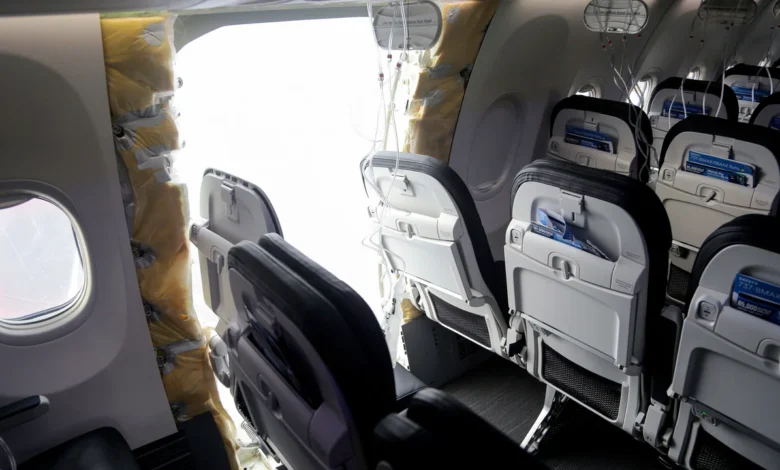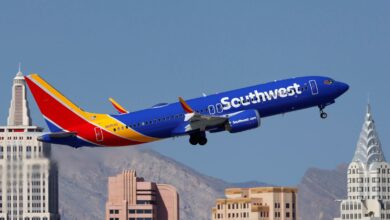What Happens When an Airplane Door Falls Off: Understanding the Risks and Safety Measures

Introduction to Airplane Doors
Airplane Door Falls Off play a critical role in both passenger safety and the overall functionality of an aircraft. There are several types of doors on commercial and private aircraft, each designed with specific purposes in mind. The primary types are entry doors, emergency exits, and cargo doors. Entry doors facilitate passenger boarding and deplaning, while emergency exits are strategically placed to ensure rapid evacuation in case of an emergency. Cargo doors, on the other hand, allow for the loading and unloading of baggage and freight, contributing to the operational efficiency of the flight.
The mechanics behind airplane doors are complex, designed to operate smoothly while ensuring a tight seal that maintains cabin pressure during flight. Most commercial aircraft utilize a plug door mechanism that relies on cabin pressure to remain securely closed. This means that when the aircraft is at cruising altitude, the higher pressure inside the cabin keeps the door firmly in place, making it virtually impossible for it to open mid-flight. Understanding the mechanics of these doors reassures passengers regarding their safety and highlights their engineering rigor.
Passengers often express concerns about the reliability of airplane doors, especially regarding incidents where an airplane door falls off during flight. Such occurrences are incredibly rare due to rigorous safety standards and testing protocols imposed by aviation authorities. Aircraft manufacturers subject their door designs to extensive durability and stress tests to prevent failure during operation. Regular maintenance checks are conducted to ensure that all operational components are functioning correctly, further mitigating risks associated with door malfunctions. Overall, the emphasis on safety in door design and operation underlines their importance in ensuring secure air travel.
Rare Incidents: The Reality of Airplane Doors Falling Off
The detachment of an airplane door during flight is an exceedingly rare occurrence, with few documented cases reported throughout aviation history. One notable incident took place in 1985 on a Boeing 737, where a door malfunction resulted in an explosive decompression of the cabin. Fortunately, the pilot managed to land the aircraft safely despite the serious risk to passengers. Investigations revealed that the incident stemmed from a combination of human error and mechanical failure, showcasing how critical rigorous maintenance checks and procedures are within the aviation industry.
Another significant event occurred in 1991, involving a McDonnell Douglas MD-11. In this case, a passenger door unexpectedly detached during the climb phase of the flight. Though alarming, the aircraft’s design included safety features that prevented immediate loss of cabin pressure, allowing the crew to maintain control. After an emergency landing, it was identified that improper sealing during pre-flight inspections contributed to the door’s detachment. This incident underlines the importance of checking all aircraft components prior to flight, emphasizing a safety culture aimed at preventing such occurrences.
While these incidents may provoke concern, statistical analysis reveals that the chances of an airplane door falling off during operation are incredibly low. The design and engineering behind airplane doors incorporate multiple redundant systems to avoid such failures. Airlines are heavily regulated, emphasizing proper maintenance and operational protocols to mitigate risks associated with aircraft malfunctions. The rarity of airplane doors detaching during flight serves as a testament to the advancements in modern aviation safety. Overall, these documented incidents provide critical insights into not only the potential causes but also the strings of safety measures that have evolved to ensure passenger protection.
Engineering and Safety Standards for Airplane Doors
Airplane doors are crucial components of aircraft engineering, subject to stringent safety standards and rigorous testing protocols. These standards ensure that doors are not only designed to withstand significant stress during flight but also function reliably in critical situations. The Federal Aviation Administration (FAA) and the European Union Aviation Safety Agency (EASA) set forth regulations that govern the design, manufacturing, and maintenance of airplane doors. Such regulations require manufacturers to develop doors that can endure extreme pressure changes, outside forces, and temperatures encountered at cruising altitudes.
The construction of an airplane door involves advanced materials engineered for strength and lightweight characteristics. Commonly used materials include aluminum alloys, composites, and reinforced plastics. These materials enhance durability and ensure that the doors maintain their structural integrity throughout the lifespan of the aircraft. Furthermore, designs incorporate multiple locking mechanisms to prevent accidental opening under various conditions. These safety features are tested extensively under simulated adverse circumstances to guarantee that an airplane door falls off is an extremely rare event.
In addition to initial design and manufacturing standards, airplane doors are subject to regular inspections and maintenance checks. Airlines are mandated to adhere to specific maintenance schedules, which include detailed examinations of door mechanisms, seals, and emergency systems. Any identified wear or potential failures are addressed promptly to ensure passenger safety. Comprehensive training for ground personnel and flight crews also plays a significant role in maintaining the integrity of these components, as they must be knowledgeable about proper door operation and emergency protocols.
The commitment of aviation authorities and aircraft manufacturers to uphold these rigorous engineering standards underscores the industry’s proactive approach to safety. Through continuous evaluation and enhancement of airplane door designs, the likelihood of incidents where an airplane door falls off remains exceedingly low.
Passenger Experience: What to Do If an Airplane Door Falls Off
Experiencing an airplane door falls off incident is an incredibly alarming situation for any passenger. It is essential to understand how to respond effectively to such a crisis. The foremost rule is to remain calm. Panic can exacerbate the situation and impede effective communication with the flight crew. Take a deep breath and focus on the information provided by the crew, as their training equips them to handle emergencies.
Upon such an event, flight attendants will typically initiate pre-established emergency protocols. Passengers should listen attentively to their instructions, as these professionals will provide guidance based on the severity of the situation. Follow their lead, as they are trained to manage crises and ensure passenger safety. If they instruct you to use an oxygen mask, assemble it as directed before assisting others, as this enhances your chances of staying conscious and aware during turbulence or disorientation.
Familiarizing oneself with the safety equipment available on board can also prove beneficial. Most commercial airplanes are equipped with life vests, oxygen masks, and flotation devices. Understanding how to locate and use this equipment before a flight can bolster confidence. In the unfortunate event that an airplane door falls off, knowing where to find these tools can facilitate a quicker response. If instructed to brace, take the position recommended by the crew; this will protect you whether the situation escalates or normalizes.
Ultimately, preparedness and adherence to crew instructions are crucial in navigating such alarming circumstances. While the likelihood of an airplane door falling off is exceedingly rare, understanding what actions to take can significantly affect individual passenger experiences and outcomes in emergencies.
Mechanical Failures: Causes of Airplane Door Detachment
The integrity of an airplane door is paramount to the safety of its occupants. Various mechanical failures can lead to the unfortunate event of an airplane door falling off during operation. One primary cause of such incidents is design flaws. Aircraft manufacturers are tasked with extensive testing and quality assurance, yet unexpected design weaknesses can emerge that compromise the door’s structural integrity over time. Such flaws may include inadequate fastening mechanisms or material vulnerabilities that become evident only under specific operational conditions.
Another significant factor contributing to airplane door detachment is wear and tear. As aircraft age and are subjected to numerous takeoffs, landings, and environmental stressors, components naturally degrade. The wear of hinges, latches, and seals can occur incrementally, often going unnoticed until it culminates in an incident. Regular inspections and assessments are critical; however, if maintenance protocols are not strictly adhered to, the risk of mechanical failure increases, potentially leading to catastrophic outcomes.
Maintenance issues also play a pivotal role in preventing an airplane door from falling off. Airlines implement rigorous maintenance schedules to ensure that all components remain in optimal working order. Yet human error, miscommunication, or the use of substandard parts can undermine these efforts. Furthermore, meticulous documentation of maintenance activities is crucial to trace potential deficiencies or oversights that could lead to door malfunction.
To mitigate these risks, airlines employ a variety of preventive measures, including enhanced training for maintenance personnel, the use of advanced technology for inspections, and adherence to strict regulatory standards. By monitoring mechanical factors systematically, airlines strive to minimize the likelihood of an airplane door detachment and ensure passenger safety during flight.
The Role of Flight Crew During Emergencies
The flight crew plays a pivotal role in maintaining safety aboard an aircraft, particularly during emergencies. Pilots and flight attendants undergo rigorous training that equips them to handle various high-stress situations. This training encompasses a multitude of scenarios, including the rare but alarming situation of an airplane door falls off during flight. These professionals must be adept at both managing the crisis and ensuring passenger safety amidst chaos.
Flight attendants receive extensive education on emergency procedures, which includes classroom instruction and practical drills. They are trained in evacuation protocols, first aid, and communication techniques tailored for high-pressure situations. In the event an airplane door were to detach, flight attendants initiate pre-established protocols to manage passenger response and mitigate panic. These protocols require quick decision-making while maintaining a calm demeanor to reassure passengers during what could be a frightening experience.
Communication is another critical responsibility of the flight crew in emergencies. After an airplane door falls off, pilots must quickly assess the situation, coordinating with air traffic control to ensure a safe landing. They communicate essential information to the flight attendants, who then relay updates to the passengers. Transparency is vital; keeping passengers informed about the situation helps mitigate fear and uncertainty. Flight attendants may explain the procedures that will follow and reassure passengers that safety measures are in place, maintaining a sense of control in a potentially uncontrolled scenario.
The collaboration between flight attendants and pilots is an essential aspect of emergency management. Together, they work to uphold safety and efficiency, ensuring that all regulatory measures are adhered to even in extreme circumstances. This cohesive effort is fundamental to the ethos of aviation safety and the trust passengers place in airline operations.
The Impact of Airplane Design on Safety
Modern airplane design has made significant strides in bolstering passenger safety, particularly concerning the structural integrity of doors. In the aviation industry, the possibility of an airplane door falls off during flight is addressed through meticulous engineering and innovative design principles. Aircraft manufacturers invest extensive resources into research and development to ensure that doors are not only robust but also anchored securely to the aircraft structure.
One of the key innovations in contemporary aircraft design is the implementation of redundancy systems. These systems provide backup mechanisms that ensure doors remain securely closed, even in the unlikely event of a primary locking mechanism failure. For instance, advanced locking mechanisms are employed, which involve multiple components working in tandem. This design philosophy ensures that if one part were to malfunction, others would still engage, significantly mitigating the chances of an airplane door falling off.
Additionally, the materials used in constructing airplane doors have evolved dramatically. New lightweight but durable materials enhance the strength of doors while decreasing the overall weight of the aircraft, contributing to fuel efficiency without compromising safety. The integration of advanced aerospace composites allows for increased durability, which plays a crucial role in withstanding the immense pressures experienced at cruising altitudes. These materials resist deformation, ensuring that the doors fit snugly within their frames even under extreme conditions.
Furthermore, rigorous testing protocols are mandated by aviation regulatory bodies to ensure that all components of an aircraft, including doors, meet stringent safety criteria. Manufacturers perform simulations that replicate various in-flight scenarios to validate the design’s effectiveness. The combination of innovative engineering, advanced material use, and thorough testing creates a robust framework that significantly reduces the risk of an airplane door falls off. These measures collectively enhance passenger safety and foster confidence in modern air travel.
Real-Life Stories: Surviving an Airplane Door Incident
Air travel is often regarded as one of the safest modes of transportation. However, there are rare but harrowing instances where passengers have faced life-threatening scenarios, including the alarming incident of an airplane door falling off. One notable account comes from a passenger aboard a regional flight who recounted the moment when an abrupt noise flooded the cabin. Moments later, chaos erupted as the rear door of the airplane detached mid-flight. This passenger described the experience as surreal, with cabin crew quickly guiding everyone to secure their oxygen masks. The frantic response helped to prevent panic as the pilot executed an unscheduled landing, underscoring the importance of safety protocols during such emergencies.
Another staggering tale originates from a cabin crew member who was on duty when an airplane door fell off shortly after takeoff. Upon hearing a loud bang, the crew quickly assessed the situation. The professionalism of the cabin crew was paramount; they instructed passengers to remain calm while expertly managing the cabin’s atmosphere. Fortunately, rigorous training prepared them for this extreme circumstance, allowing them to facilitate the safe landing of the aircraft despite the challenges posed by depressurization. The crew’s ability to keep passengers informed and collected greatly contributed to the positive outcome of that harrowing flight.
Various accounts illustrate that while the likelihood of an airplane door detaching is minuscule, the repercussions can be profound. Survivors highlight the significance of rigorous safety measures and preparedness in aviation. Their stories serve not only to acknowledge the risks but also to emphasize the remarkable resilience and resourcefulness that emerge during such crises. These personal experiences remind us of the human element in the face of aviation challenges and the vital importance of ongoing safety improvements and protocols in the industry.
Conclusion: Ensuring Air Travel Safety
In summarizing the critical aspects surrounding the rare occurrences of an airplane door falling off, it is essential to recognize that the engineering standards for commercial aircraft are stringent and meticulously adhered to. The aviation industry prioritizes safety, ensuring that all components, including doors, undergo rigorous testing and maintenance protocols. Such measures significantly mitigate the risks associated with any potential malfunction. It is a well-documented fact that airplane door incidents are infrequent, contributing to overall air travel being one of the safest modes of transportation available.
Additionally, the design of airplane doors includes several features that prevent them from opening mid-flight, a situation that is virtually impossible under normal operating conditions. This includes mechanisms that work in conjunction with cabin pressure, ensuring that doors remain securely closed even in the unlikely event of a failure in the locking mechanism. Pilots and cabin crew are extensively trained to handle emergencies, thereby further reinforcing safety measures in the event of unexpected situations.
As passengers, it is crucial to maintain confidence in the aviation system and to respect the safety protocols established by airlines. Travelers should be aware that all personnel involved in air travel, from maintenance crews to flight attendants, are dedicated to ensuring a safe journey. Following safety instructions and remaining attentive during pre-flight briefings contributes to individual and collective safety during flights. Furthermore, understanding the engineering behind modern aircraft can help alleviate concerns regarding incidents like an airplane door falling off.
Ultimately, the collaboration of advanced technology, thorough regulatory oversight, and dedicated professionals makes air travel a remarkably secure experience. By adhering to safety protocols and fostering awareness of safety measures, passengers can confidently enjoy the benefits of air travel.
You May Also Read This Usaworldtoday.


